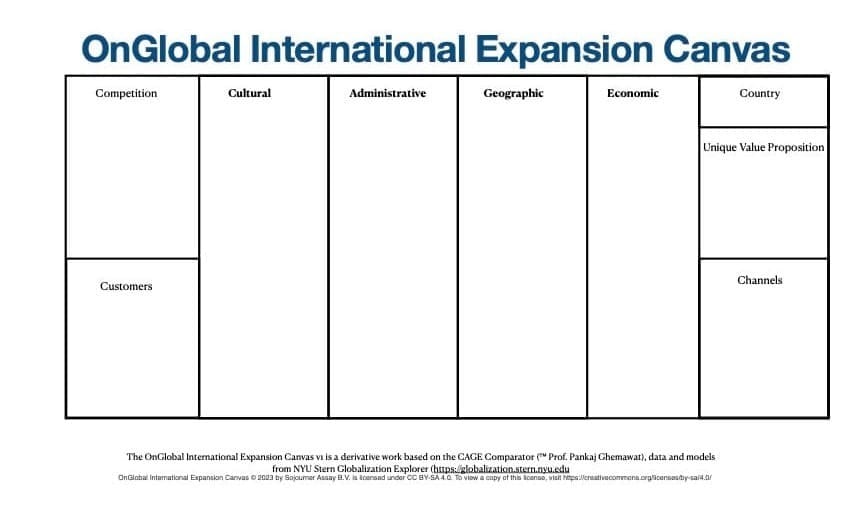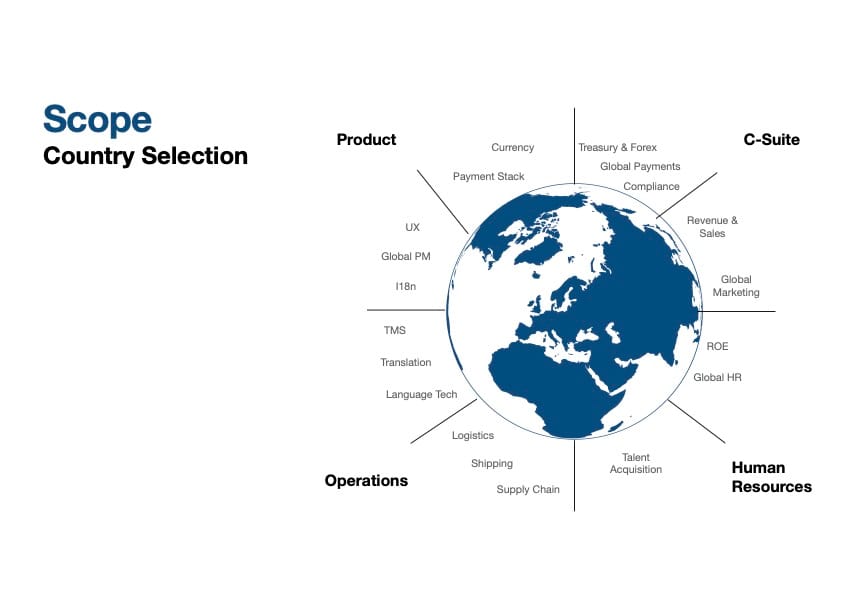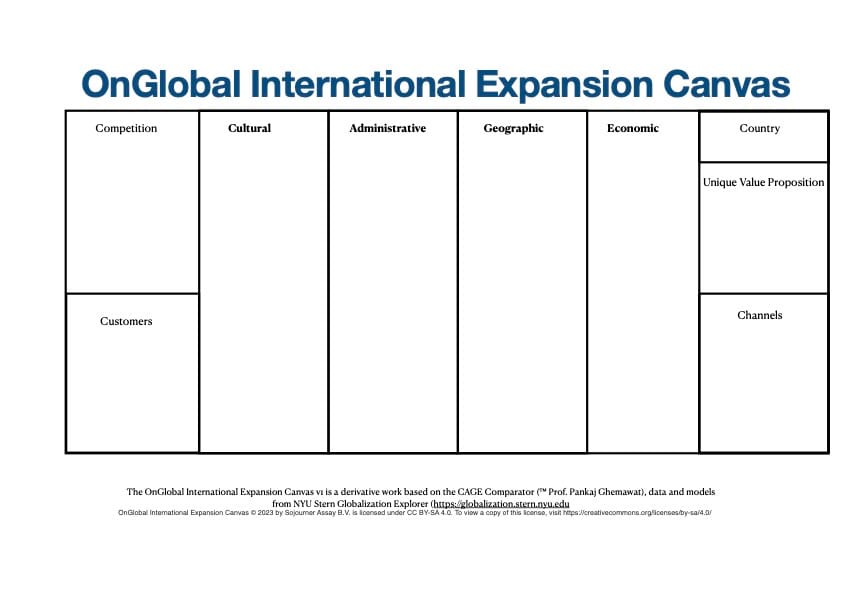The OnGlobal (CAGE) International Expansion Canvas.
We believe science and data should drive market selection using the CAGE framework.

Almost fifteen years ago, McKinsey advised their clients:
'The annals of business history report that for every successful market entry, about four fail. Inexperienced start-ups suffer some of these disappointments, but so do many sophisticated corporations and seasoned entrepreneurs who should know better" (Beating the Odds in Market Entry. McKinsey. Nov 1, 2005)
Today, that measure has no demonstratable improvement. A personal story:
Upon relocating to the Netherlands, I was delighted to see a flagship Canadian retailer, The Bay, prominently on one of Amsterdam's most prestigious streets. Starting as a fur trader, The Hudson's Bay Company became Canada's oldest and largest corporation. Similar in fame (and infamy) as the Dutch VOC.
It was a little beachhead from home in my new country—a place where I could find familiar things and a demonstrable case of a Canadian international success story that I could reference to the Dutch.
It was a spectacular failure...
According to financial analysts:
This multinational expansion was too much for Hudson's Bay to manage, particularly in light of the tough competitive environment facing department stores. As a result, the company has been bleeding cash and posting sizable losses in recent years.
It seems clear that the cost of exiting the Netherlands will total hundreds of millions of dollars, including severance payments, lease buyouts, and losses from the big markdowns needed to clear inventory. The Motley Fool.
Hundreds of millions in losses to withdraw from a single European country, arguably one of the richest and most mature markets in the European Union.
Where did this Canadian success story go wrong? Should it have never left the choice of the Netherlands? Or was it the choice of the Netherlands that was causal to the failure?
Your next country - a crucial choice.
The impact of the choice of which country you will land in will dictate your company's direction and actions for months, possibly years.
"Where you land - and how effectively you do it - can have enormous consequences on your global business's success." (Frontline.vc "Where to Land. Selecting your European HQ" 2021 Edition)

A shared struggle for many companies.
I spoke with Aaron McDaniel and Klaus Wehage shortly after they released "Global Class - How the World's Fastest-Growing Companies Scale Globally by Focusing Locally."
The call-out market selection (and presumably entry) in their book's introduction (p14):
"On a similar note, there are some areas of the global growth initiative planning and implementation process that we don't address directly namely market selection. We avoid this topic because we have found in our research that the criteria companies use to choose markets to enter can range from highly customized to a specific industry, to directly related to where there is already organic growth, to haphazard (with rationale ranging from selecting locations where investors are located, to picking countries company executives studied abroad in during college or visited once). All companies should evaluate key economic indicators, local market dynamics, and so on to narrow down to a short list of target markets. Outside of foundational elements of mindset and strategy, our tools and frameworks pick up once the decision has been made to expand to international markets and there is a list of target markets to explore."
I've seen similar patterns in my research: the three G's of going global the wrong way: gut feeling, GDP, and Google.
Three common but misguided approaches.
Gut Feeling
An amazing amount of market selection is still on gut feel.
Let's hope your CEO is beyond choosing the best country based on the climate and potential holiday home locations, but that often falls near the top.
A similar basis was observed when selecting a market based on where they did their EMBA 'international trip destination.' It is as if a two-week visit can tell you everything you need to know. (Credit to Frontline.vc for their observation.)
GDP Gross Domestic Product
The next wrong way is to prioritize GDP. If you can tell me how to calculate GDP, I'll let you use it for market selection. Otherwise, it is riddled with problems. I've written about that here.
Google is great if you know the specifics of what you are searching for. Often, nomenclature for business practices and products changes from country to country. A localization manager will advise teams that can further change by individual local.
A "What is a local?" side-bar: A local is a set of user specific preferences that define the handeling and usage of of language and informaiton. The most general of which is associated with a geographic region, including subsets of a region such as a city. An example: The city of London uses english, the pound to express currency is located in the Grenwhich Mean Time timezone in the summer season.
Existing product names can change by region. What words would describe an automated debit from a bank account? Here are a few variants:
- US: Direct Debit or ACH
- Canada: Pre-authorized Debit
- South Africa: Debit Order
- Netherlands: Automatische Incasso
- Germany: Lastschriftverfahren
What do you search for when looking for new products? Would Google's Market Planner have been helpful for AirBnb or any new business model?
There must be a better way.
A data-driven framework (and canvas) for country selection.
Enter the CAGE Framework.
The CAGE framework was developed by Dr. Pankaj Ghemewat, a renowned educator on globalization, who wrote the classic HBR article "Distance Still Matters: The Hard Reality of Global Expansion".
The CAGE framework is not new. Its strength is in the methodology used to derive it, regression testing on global information flows—people, capital, goods, and services.
The central thesis behind the framework is (in my words):
"Differences Dampen Flows"
All products and services start somewhere and expand across borders. Or, to put it into localization terms, a new local. The differences between those locals determine how easily that expansion will be.
The framework shows that investing in bridging the difference between one data element, Language, and flow increases by 46 - 50%, depending on the business. So, your chance of success correlates with that amount.
Localization readers should also love this framework: It makes localization central to international expansion. Localization is the custodian of the differences between locals—up until now, language. However, all the other local-specific differences comprise the data points from which the CAGE framework is derived.
It's tempting to think these differences don't apply to our digital world. That's simply wrong, and the data proves that. However, the idea persists that digital companies can expand without thought or planning.
The OnGlobal International Expansion Canvas
Do we need another canvas?
Many misunderstand the purpose behind a canvas. Treating it as a 'permission to fire form.'( BBC TV's presentation of The Hitchhiker's Guide to the Galaxy.)
A canvas fulfills two roles: An abstraction and a thinking tool.
First, what is the concept of abstraction? Programmers and engineers are familiar with this. Here, I reference its linguistic roots for our localization audience:
Abstraction (from the Latin abs, meaning away from and trahere , meaning to draw) is the process of taking away or removing characteristics from something in order to reduce it to a set of essential characteristics. (TechTarget)
Second, it guides your thinking. I am embedding the CAGE Framework into the OnGlobal International Expansion Canvas to highlight the key factors impacting international flows. These are directly related to market entry success or failure.

The OnGlobal (CAGE) International Expansion Canvas is free to download using this form:
Upon request, I can also supply a video-based course to show you how best to use the OnGlobal International Canvas to guide your international expansion.
I hope this helps move international expansion from being driven by gut feeling, gross domestic product, and Google to being guided by the data-driven CAGE Framework, as encapsulated in the OnGlobal International Expansion Canvas.
OnGlobal International Expansion Canvas © 2023 by Sojourner Assay B.V. is licensed under CC BY-SA 4.0
